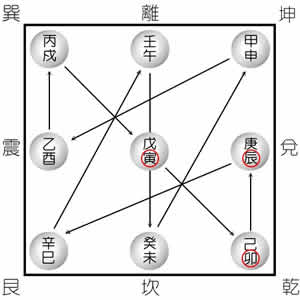Sexagenary Cycle: Ten Heavenly Stems and Twelve Earthly Branches

Source: Wikipedia
The Chinese sexagenary cycle, also known as Stems-Branches, is a cyclic numeral system of 60 combinations of the two basic cycles, the ten Heavenly Stems and the twelve Earthly Branches
This traditional Chinese calendrical system is used as a means of numbering days and years, not only in China but also in other East Asian nations like Japan, Korea, and Vietnam. The Sexagenary system is also important in Chinese astrology and Chinese fortune telling.
 The cycle was used in China since the second millennium BC (it has been found on Shang dynasty oracle bones), as a means of naming days (just as western cultures use the days in the week). This use of the cycle for days is attested throughout the Zhou dynasty. For instance, most entries in the Spring and Autumn Annals use this system. Its use for recording years is more recent. It became widespread in the Western Han Dynasty (202 BC- 8 AD), and might have begun in the late Warring States period. The year 1984 began the present cycle, and 2044 will begin another.
The cycle was used in China since the second millennium BC (it has been found on Shang dynasty oracle bones), as a means of naming days (just as western cultures use the days in the week). This use of the cycle for days is attested throughout the Zhou dynasty. For instance, most entries in the Spring and Autumn Annals use this system. Its use for recording years is more recent. It became widespread in the Western Han Dynasty (202 BC- 8 AD), and might have begun in the late Warring States period. The year 1984 began the present cycle, and 2044 will begin another.
The calendar is calculated by combining the Ten Heavenly Stems and the Twelve Earthly Branches. These two sets of terms were used to enumerate years of the civil calendar. Combining the series form a greater cycle of 60 terms, as the least common multiple of 10 and 12 is 60. The first term is formed by adding the first stem to the first branch, then the second stem to the second branch, and so on. If you start with kinoe-ne/kōshi, so the 61st year would also be kinoe-ne. This was how the tradition of celebrating the 60th birthday began. This counting system employing things of nature and animals create many myths, and people of Japan today still consider the good and bad luck of certain days and years.
The 1st day of a new year in the sexagenary cycle should be the Lichun.
The Tibetan calendar also counts years using a 60-year cycle based on 12 animals and 5 elements, but while the first year of the Chinese cycle is always the year of the Wood Rat, the first year of the Tibetan cycle is the year of the Fire Hare (year #4 on the Chinese cycle).
1. Ten Heavenly Stems
| Heavenly Stem |
Chinese name (Mandarin pron. in pinyin) |
Yin yang | Wu xing | |
|---|---|---|---|---|
| 1 | 甲 | jiǎ | yang | wood |
| 2 | 乙 | yǐ | yin | |
| 3 | 丙 | bǐng | yang | fire |
| 4 | 丁 | dīng | yin | |
| 5 | 戊 | wù | yang | earth |
| 6 | 己 | jǐ | yin | |
| 7 | 庚 | gēng | yang | metal |
| 8 | 辛 | xīn | yin | |
| 9 | 壬 | rén | yang | water |
| 10 | 癸 | guǐ | yin |
2. Twelve Earthly Branches
| Earthly Branch |
Chinese name (Mandarin pron. in pinyin) |
Chinese zodiac |
Corresponding hours |
|
|---|---|---|---|---|
| 1 | 子 | zǐ | Rat | 11 p.m. to 1 a.m. |
| 2 | 丑 | chǒu | Ox/Buffalo | 1 to 3 a.m. |
| 3 | 寅 | yín | Tiger | 3 to 5 a.m. |
| 4 | 卯 | mǎo | Rabbit/Hare | 5 to 7 a.m. |
| 5 | 辰 | chén | Dragon | 7 to 9 a.m. |
| 6 | 巳 | sì | Snake | 9 to 11 a.m. |
| 7 | 午 | wǔ | Horse | 11 a.m. to 1 p.m. |
| 8 | 未 | wèi | Sheep/Goat | 1 to 3 p.m. |
| 9 | 申 | shēn | Monkey | 3 to 5 p.m. |
| 10 | 酉 | yǒu | Chicken/Rooster | 5 to 7 p.m. |
| 11 | 戌 | xū | Dog | 7 to 9 p.m. |
| 12 | 亥 | hài | Pig/Boar | 9 to 11 p.m. |
*The names of several animals can be translated into English in several different ways.
3. Sexagenary Cycle
| Stem-Branch | Chinese name |
Associations | |
|---|---|---|---|
| 1 | 甲子 | jiǎ-zǐ | Yang Wood Rat |
| 2 | 乙丑 | yǐ-chǒu | Yin Wood Ox |
| 3 | 丙寅 | bǐng-yín | Yang Fire Tiger |
| 4 | 丁卯 | dīng-mǎo | Yin Fire Rabbit |
| 5 | 戊辰 | wù-chén | Yang Earth Dragon |
| 6 | 己巳 | jǐ-sì | Yin Earth Snake |
| 7 | 庚午 | gēng-wǔ | Yang Metal Horse |
| 8 | 辛未 | xīn-wèi | Yin Metal Sheep |
| 9 | 壬申 | rén-shēn | Yang Water Monkey |
| 10 | 癸酉 | guǐ-yǒu | Yin Water Chicken |
| 11 | 甲戌 | jiǎ-xū | Yang Wood Dog |
| 12 | 乙亥 | yǐ-hài | Yin Wood Pig |
| 13 | 丙子 | bǐng-zǐ | Yang Fire Rat |
| 14 | 丁丑 | dīng-chǒu | Yin Fire Ox |
| 15 | 戊寅 | wù-yín | Yang Earth Tiger |
| 16 | 己卯 | jǐ-mǎo | Yin Earth Rabbit |
| 17 | 庚辰 | gēng-chén | Yang Metal Dragon |
| 18 | 辛巳 | xīn-sì | Yin Metal Snake |
| 19 | 壬午 | rén-wǔ | Yang Water Horse |
| 20 | 癸未 | guǐ-wèi | Yin Water Sheep |
| 21 | 甲申 | jiǎ-shēn | Yang Wood Monkey |
| 22 | 乙酉 | yǐ-yǒu | Yin Wood Chicken |
| 23 | 丙戌 | bǐng-xū | Yang Fire Dog |
| 24 | 丁亥 | dīng-hài | Yin Fire Pig |
| 25 | 戊子 | wù-zǐ | Yang Earth Rat |
| 26 | 己丑 | jǐ-chǒu | Yin Earth Ox |
| 27 | 庚寅 | gēng-yín | Yang Metal Tiger |
| 28 | 辛卯 | xīn-mǎo | Yin Metal Rabbit |
| 29 | 壬辰 | rén-chén | Yang Water Dragon |
| 30 | 癸巳 | guǐ-sì | Yin Water Snake |
| 31 | 甲午 | jiǎ-wǔ | Yang Wood Horse |
| 32 | 乙未 | yǐ-wèi | Yin Wood Sheep |
| 33 | 丙申 | bǐng-shēn | Yang Fire Monkey |
| 34 | 丁酉 | dīng-yǒu | Yin Fire Chicken |
| 35 | 戊戌 | wù-xū | Yang Earth Dog |
| 36 | 己亥 | jǐ-hài | Yin Earth Pig |
| 37 | 庚子 | gēng-zǐ | Yang Metal Rat |
| 38 | 辛丑 | xīn-chǒu | Yin Metal Ox |
| 39 | 壬寅 | rén-yín | Yang Water Tiger |
| 40 | 癸卯 | guǐ-mǎo | Yin Water Rabbit |
| 41 | 甲辰 | jiǎ-chén | Yang Wood Dragon |
| 42 | 乙巳 | yǐ-sì | Yin Wood Snake |
| 43 | 丙午 | bǐng-wǔ | Yang Fire Horse |
| 44 | 丁未 | dīng-wèi | Yin Fire Sheep |
| 45 | 戊申 | wù-shēn | Yang Earth Monkey |
| 46 | 己酉 | jǐ-yǒu | Yin Earth Chicken |
| 47 | 庚戌 | gēng-xū | Yang Metal Dog |
| 48 | 辛亥 | xīn-hài | Yin Metal Pig |
| 49 | 壬子 | rén-zǐ | Yang Water Rat |
| 50 | 癸丑 | guǐ-chǒu | Yin Water Ox |
| 51 | 甲寅 | jiǎ-yín | Yang Wood Tiger |
| 52 | 乙卯 | yǐ-mǎo | Yin Wood Rabbit |
| 53 | 丙辰 | bǐng-chén | Yang Fire Dragon |
| 54 | 丁巳 | dīng-sì | Yin Fire Snake |
| 55 | 戊午 | wù-wǔ | Yang Earth Horse |
| 56 | 己未 | jǐ-wèi | Yin Earth Sheep |
| 57 | 庚申 | gēng-shēn | Yang Metal Monkey |
| 58 | 辛酉 | xīn-yǒu | Yin Metal Chicken |
| 59 | 壬戌 | rén-xū | Yang Water Dog |
| 60 | 癸亥 | guǐ-hài | Yin Water Pig |
4. Application
The sexagenary cycle was first used for days in the Shang Dynasty, and later also used for years and less commonly for months.
For example, the year 2000 was the 17th year of the 78th sexagenary cycle, a gēng-chén year (庚辰年), a year of the Yang Metal Dragon. Therefore, 2006 is the 23rd year of the 78th sexagenary cycle, called a bǐng-xū year (丙戌年), a year of the Yang Fire Dog; 2007 a year of the Yin Fire Pig.
The naming of the months and days is not common now, although they are shown on Chinese calendars and almanacs.
- Attention: In common practice, the “combination” elements (Chinese agricultural calendar) should be applied for the Sexagenary Cycle. Either the “Heavenly Stem” or the “Earthly
- Branch” alone is not enough to determine the element for any year within the 60 years of the Sexagenary Cycle.
- The writing of “Yang Earth Rat”(e.g., 2008), etc., is not recommended for use, because people might misinterpret “Earth” as the “Element” of that year (2008).
OPENING HOURS
| Week Days | 8:00 – 5:00 |
| Saturday | 9:00 – 5:00 |
| Sunday | 11:00 – 4:00 |




